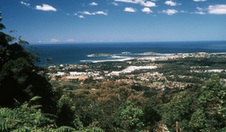Homelessness in NSW – some facts and figures
• In the middle of a cold and wet winter, across New South Wales, around 27,0001 people are homeless. They sleep in parks, under bridges, with friends or strangers, in vulnerable situations. Across NSW about only 15% of homeless people are lucky enough to get a place in a crisis refuge.
• In NSW, the percentages of where homeless people are sleeping are: - 45% with friends and relatives - 29% in boarding houses - 15% in SAAP accommodation - 11% in improvised dwellings and tents
• Of the almost 27,000 experiencing homelessness, 39% are women. These can be single women as well as women and children escaping domestic violence.
• 46% of those who are homeless are under 25 and almost 10,000 are under 12. Young people experiencing homelessness are often running away from families characterized by poverty, violence and drug and alcohol abuse.
• Indigenous people are more likely to experience homelessness than other Australians. Two percent of the population identified as Indigenous at the 2001 census, but 16% of clients in homeless assistance services were Aboriginal in 2001-022.
• Contrary to popular belief there are homeless people in regional areas:
- 39 people in every 10,000 are homeless in Sydney.
- 47 people in every 10,000 are homeless in NSW Regional areas.
• The Demand for SAAP Accommodation by homeless people 2004-053 report shows that NSW has the highest turn-away numbers of any State and Territory, with 58 potential clients and 33 accompanying children with valid requests for immediate accommodation being turned away each day.
• Across Australia more people with valid requests for immediate accommodation were turned away than were accommodated by a crisis refuge. Only one in two people with a valid request for accommodation received it, and three out of five accompanying children were turned away4.
1 Chamberlain, Chris. Counting the Homeless 2001: Australia
Australian Institute of Health and Welfare (2001), SAAP National Data Collection Annual Report 2001-02, Canberra: Australian Institute of Health and Welfare, Cat. No. HOU 61 2
3
4 Australian Institute of Health & Welfare 2004. Demand for SAAP assistance by homeless people 2002-03: a report from the SAAP National Data Collection. AIHW cat no. HOU 110. Canberra: AIHW (SAAP NDCA report. Series 8).
• Across Australia family groups were turned away in high proportions from crisis refuges. This was highest for couples with children and couples without children, where only one in five requesting groups were accommodated (81% were turned away). Sixty-four per cent of single people with children requesting accommodation were turned away.
• Despite recording the highest number of homeless people in the 2001 Census, NSW has not developed a homelessness strategy5. HomelessnessNSW.ACT is calling for the NSW Government to develop a Homelessness Strategy to ensure a better coordinated response to homelessness. Being homeless is a complex issue, created by the failure of a variety of service systems. Homeless people and those at risk of becoming homeless are affected by common themes that include social exclusion, an ineffective service system, lack of access to housing that is affordable to people on low incomes and a lack of support and supported accommodation services.
5 Chamberlain, C and MacKenzie, D, Australian Census Analytic Program, Counting the Homeless 2001, Australian Bureau of Statistics, ABS Catalogue No. 2050.0
Wednesday, August 1, 2007
Subscribe to:
Post Comments (Atom)



No comments:
Post a Comment